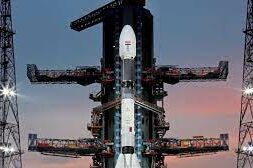
NEW DELHI, May 29: The Indian Space Research Organisation (ISRO) on Monday successfully placed into Geosynchronous Transfer Orbit the NVS-01 navigation satellite weighing about 2232 kg. The Geosynchronous Satellite Launch Vehicle (GSLV) which placed the satellite, lifted off with a thunderous roar precisely at 10.42 a.m. from the second launch pad at the Satish Dhawan Space Centre SHAR, Sriharikota.
In a statement ISRO said, “After a flight of about 19 minutes, the NVS-O1 satellite was injected precisely into a Geosynchronous Transfer Orbit. Subsequent orbit-raising manoeuvres will take NVS-01 into the intended geosynchronous orbit.”
Talking from the control room ISRO Chairman S. Somanath congratulated the team behind this mission and said GSLV has placed the satellite in the precise orbit. He further said, “This mission happened after the debacle that we had in the F10 mission where there was an issue in the cryogenic stage. I’m very happy about the corrections and modifications that we have done in this stage as well as the lessons that we learnt out of it to make our cryogenic stage more reliable.” He also mentioned that NVS-01 is the first in the series of five satellites.
According to details provided by ISRO, the GSLV-F12 is the 15th flight of India’s GSLV and the 9th flight with indigenous cyro stage. This is the 6th operational flight of GSLV with indigenous cryogenic stage. The NVS-01 carried navigation payloads L1, L5 and S bands. Interestingly, for the first time, an indigenous atomic clock was flown in NVS-01.
Later during a press meet, the Chairman said the space agency is planning to launch the weather satellite INSAT-3DS with Geosynchronous Satellite Launch Vehicle (GSLV). He also said the ISRO would have to complete the navigation satellite constellation by launching four more NVS series satellites. ISRO was also working on designing a new rocket that can carry much higher luggage and also upgrading the LVM3 rocket to lift up to 5.5 tonnes from the current 4 ton capacity.
Noting that the next few months will be busy for team ISRO, Somanath said in July ISRO would test the crew escape systems for the Gaganyaan project rocket. He said, “We have to get the crew module and crew escape system. And by July we will integrate them with the rocket,” he noted. ISRO intends to do a test at an altitude of 14 km where systems would be destroyed. And this will be done to check how the crew can be saved in case of a mishap. The Chairman said that other systems for Gaganyaan are being tested at various centres of the space agency. The unmanned Gaganyaan mission is planned for early next year.
(Manas Dasgupta)













